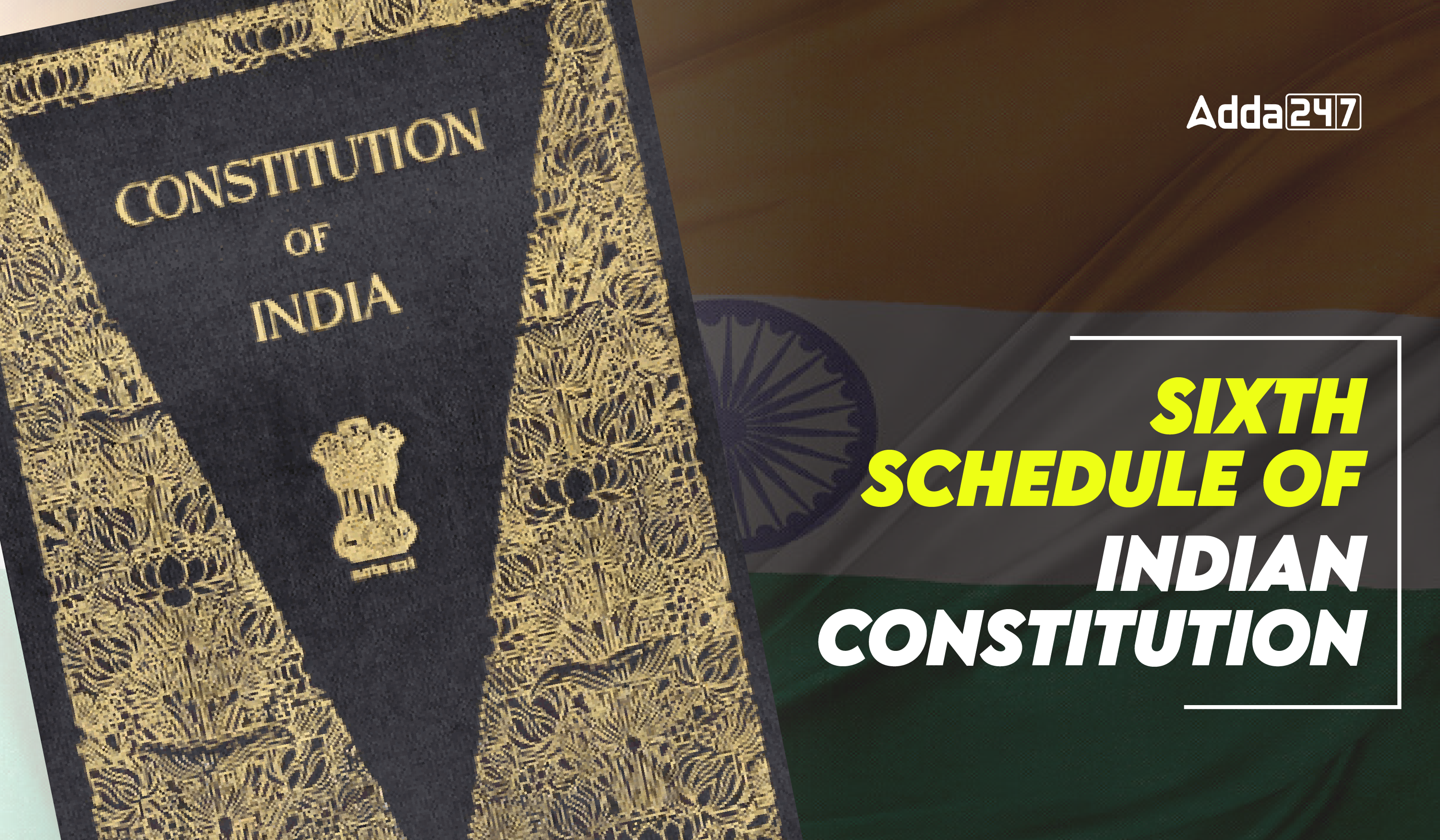Table of Contents
Sonam Wangchuk, a well-known environmentalist and entrepreneur, recently embarked on a three-week hunger strike to call for Ladakh’s statehood and inclusion in the Indian Constitution’s Sixth Schedule. The Sixth Schedule of the Indian Constitution grants autonomy to tribal areas in Assam, Meghalaya, Tripura, and Mizoram. It establishes District Councils with legislative, executive, and judicial powers over specific matters like land, forests, and social customs.
Under the 6th Schedule some of the tribal areas as separate legal bodies by the administration. Constitution of India, Articles 244(2) and 275(1) include the provisions of the sixth schedule.
Objectives of the Sixth Schedule
The following are the objectives of the Indian Constitution’s Sixth Schedule:
- To establish provisions for the management of tribal regions in the northeastern states of Mizoram, Tripura, Meghalaya, and Assam.
- To safeguard tribal lands and resources and forbid the transfer of such resources to people or communities who are not tribal.
- To guarantee that non-tribal groups do not take advantage of or marginalize tribal communities and that their social and cultural identities are upheld and encouraged.
Provisions of the 6th Schedule
The following are the Sixth Schedule’s key clauses.
Article 244(2): The administration of the tribal territories in the States of Assam, Meghalaya, Tripura, and Mizoram shall be governed by the provisions of the Sixth Schedule.
Districts and territories with autonomy
- The four states of Assam, Meghalaya, Tripura, and Mizoram contain tribal areas that will be governed as Autonomous Districts.
- The governor may create Autonomous Regions inside an autonomous district if there are distinct Scheduled Tribes living there.
- The authority to rearrange the autonomous districts rests with the Governor.
- Additionally, he has the authority to change the name or expand the limits of any autonomous district.
Constitution of District and Regional Councils
- In every autonomous district, there will be a District Council with a maximum of thirty members. Of these, no more than four will be appointed by the Governor, and the remaining members will be chosen by adult suffrage.
- Every territory created as an autonomous region will have its own Regional Council.
Legislative authority granted to District and Regional Councils
- These bodies have the authority to enact legislation for many specific topics, including land use, forest management (apart from the Reserved Forest), property inheritance, and other related issues.
Justice administration in autonomous regions and districts
- The District and Regional Councils have the authority to establish Village and District Council Courts to hear lawsuits and disputes in which all parties are Scheduled Tribe members living in the district.
- On the other hand, situations involving crimes carrying a death sentence or a five-year or longer prison sentence are outside the jurisdiction of the Council Courts.
- The District and Regional Councils have the authority to tax occupations, trades, animals, cars, and other things in addition to assessing and collecting land revenue.
- The authority to issue permits or leases for the mining of minerals under their purview has been delegated to the Councils.
- The authority to create, build, or oversee elementary schools, pharmacies, marketplaces, cattle ponds, fisheries, highways, road transportation, and waterways within their districts has been delegated to the District Councils and Regional Councils.
- The actions of the state legislature or Parliament do not apply to autonomous districts and regions, or they apply with certain changes and exclusions.
- Any matter concerning the administration of the autonomous districts or regions may be the subject of an investigation and report by a commission appointed by the governor.
Four States have Designated Tribal Areas
Four states in India have designated tribal areas granted special provisions under the Sixth Schedule of the Indian Constitution. These states are:
Assam
- North Cachar Hills District,
- The District of Karbi Anglong
- The District of Bodoland Territorial Areas
Meghalaya
- Khasi Hills District
- The Jaintia Hills Area
- The District of Garo Hills
Tripura
- Tripura Tribal Areas
Mizoram
- The District of Chakma
- The District of Mara
- The District of Lai
These designated tribal areas enjoy a degree of autonomy within the states, allowing them to govern themselves in certain matters related to their traditions and customs. This autonomy aims to preserve the unique cultural identity and self-governance practices of these tribal communities.
History of Sixth Schedule of Indian Constitution
Schedule Six to the Indian Constitution was historically developed per a series of Acts and Regulations that cleared the path for the creation of the current Schedule Six.
- The British Presidency made its first move to exclude the tribal areas from the mainland legal system with the passing of the “Garo Hills Act, of 1869.”
- Later, a new development was monitored by the “Government of India Act, of 1870,” which gave the executive authority to enact laws for the regions covered by the “Garo Hills Act, of 1869.”
- The “Scheduled Districts Act,” which was passed in 1874, changed the way legislation operated. The “Chief Commissioner” in Assam now has the same authority as the former “Lt. Governor of Bengal.”
- The importance of the governor’s function was highlighted by the 1918 “Montagu-Chelmsford Report.”
- The “Simon Commission,” also known as the “Indian Statutory Commission, 1930,” conducted a thorough examination of the state of these tribal regions.
- The phrase “excluded areas” or “partially excluded areas” was added to the existing structure by the “Government of India Act, 1935” in place of the term “backward areas.” The act’s purpose is to draft the Indian Constitution’s Schedule Six.
Fifth and Sixth Schedule Cooperation
In most of the communities that are scheduled in the country’s forested and steep areas, tribes have long resided. They have developed a unique culture as a result of decades of seclusion. They were never fond of outside intervention. These regions were designated as Scheduled areas upon independence under the constitution’s provisions, which included many administrative guidelines.
| Fifth and Sixth Schedule | |
| Fifth Schedule | Sixth Schedule |
| Includes provisions for the management of tribal lands in any state, except for Mizoram, Assam, Meghalaya, and Tripura. | Includes guidelines for managing tribal regions in Assam, Meghalaya, Tripura, and Mizoram. |
| The term “Scheduled Areas” in the Constitution refers to any regions that the President may designate as such by decree. | The name or territorial jurisdiction of any Autonomous District or Autonomous Region may be changed, or the Governor may establish a new one. |
| Possess less independence | Greater autonomy in terms of judicial, budgetary, legislative, and executive authority. |
Benefits of the 6th Schedule of India
- The formation of Autonomous District Councils, which have some degree of legislative, judicial, and administrative autonomy inside a state, is one way that the Sixth Schedule has aided in the democratic devolution of powers.
- A region’s language, cultural practices, and customs are protected when it is included in the sixth schedule.
- The protection of tribal land rights has been aided by the Sixth Schedule, which gives autonomous councils the authority to enact laws on issues such as land, forests, and fisheries.
- For quick development and change, sixth schedule areas are given a larger amount of grant-in funds. Recommendations from the Finance Commission for grant-in aids for the sixth scheduled areas
- When a region is listed on the sixth schedule, it guarantees that its socio-economic growth aligns with the core value of sustainability.
Difficulties related to Schedule Six?
The Sixth Schedule raises the following issues
- Various tribal groups governed by a single independent council: Tribal populations with diverse traditions and customs exist inside a single autonomous council. For instance, there are thirteen tribes in the North Cachar Hills territory (now known as Dima Hasao); the principal tribes are the Dimasa, Kuki, Zeme, Hmar, and Karbi.
- Insufficient funding allocation: According to the members of the Chakma, Lai, and Mara Councils, there should be a distribution of cash to local councils based on their degree of backwardness rather than their population, as the monies allocated by the Central Government are deemed insufficient.
- Devolution of power: Although the autonomous district councils (ADCs) have been given considerable legislative authority, the state governments continue to play a major role in these regions’ administration, which restricts the ADCs’ efficacy.
- Inter-tribal conflicts: Although the ADCs are supposed to represent the interests of all tribal communities within a district, disputes between various tribal groups can occasionally arise from the political process involved in choosing the ADC members.
- Corruption and accountability: There have been claims of financial mismanagement and corruption in the ADCs’ operations. As a result, their operations lack accountability and transparency.
- Lack of knowledge and involvement: Many tribal tribes are not completely informed of the Sixth Schedule’s provisions and their legal rights as a result. This may result in a lack of interest in politics and a distorted perception of the advantages of the ADCs.
Latest Ladakh Demand
- Ladakh has seen many development initiatives in the past few years after the Indian Constitution of the 6th Schedule. These include the first green hydrogen unit and geothermal power plant in India.
- Additionally, plans call for constructing seven hydropower plants on the Indus River and its tributaries.
- These quick development initiatives put Ladakh’s delicate ecology in jeopardy.
- Ladakhis have pushed for their territory to be included in the Sixth Schedule of the Indian Constitution to save the region’s delicate ecosystem.
- Additionally, more than 97% of Ladakh’s population is tribal, meeting the requirements for Sixth Schedule status.
Actions taken to ensure the Sixth Schedule is implemented effectively
- Strengthening Autonomous District Councils (ADCs): To guarantee efficient operation, the ADCs should be provided with sufficient staff, financial and administrative authority, and resources.
- Eliminating disparity among council: To properly implement the requirements outlined for the Tribal people in the sixth schedule for their better future, effective measures must be taken to eliminate disparities among council, state, and central responsibilities.
- Adding other areas: More regions with sizable indigenous populations ought to be included in the Sixth Schedule’s purview. This would support the development of the tribal people and safeguard their rights and interests.
- Boost autonomy: More authority to conduct business on their own should be granted to the autonomous district councils (ADCs) created under the Sixth Schedule. This would support the growth and empowerment of the tribal groups.
- Promoting community involvement: The successful implementation of the Sixth Schedule depends on the local tribal groups’ engagement in the decision-making process.
- Frequent observation and assessment: Regular monitoring and evaluation of the Sixth Schedule’s implementation should be carried out by the government.
The government can create a committee or agency to oversee all budget allocation actions in the various sectors included in the schedule, ensuring that these areas receive equal opportunity for development and growth.



 TSPSC Group 1 Question Paper 2024, Downl...
TSPSC Group 1 Question Paper 2024, Downl...
 TSPSC Group 1 Answer key 2024 Out, Downl...
TSPSC Group 1 Answer key 2024 Out, Downl...
 UPSC Prelims 2024 Question Paper, Downlo...
UPSC Prelims 2024 Question Paper, Downlo...





